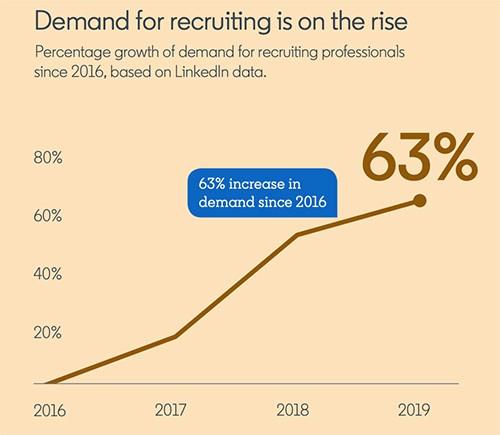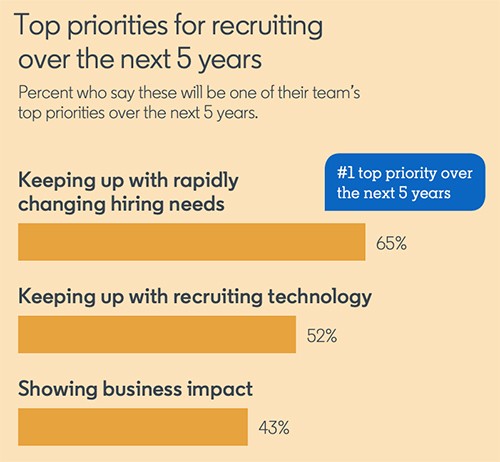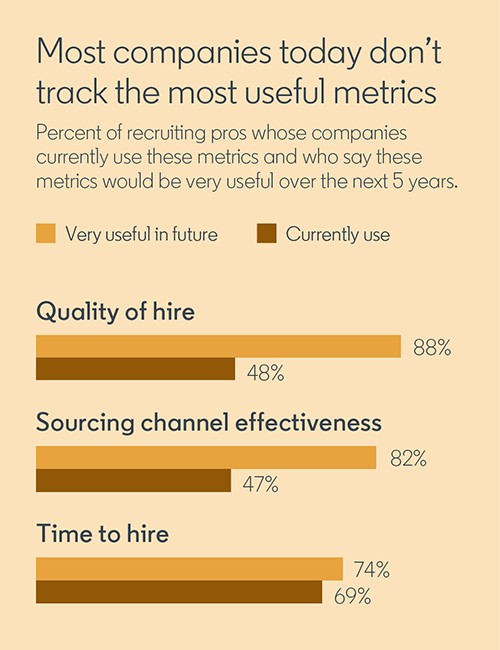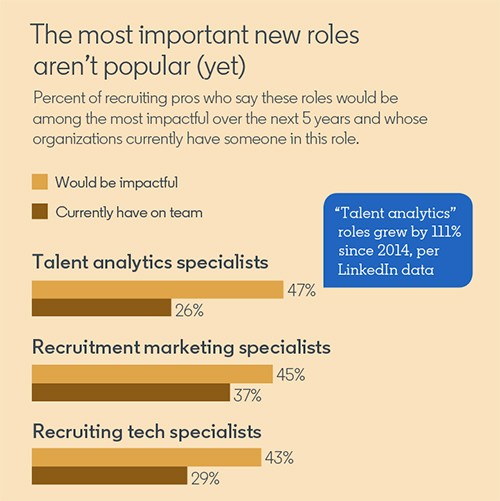
New Report: 7 Predictions on How Recruiting Will Be Different in 2025

If you’re in recruiting today, your job will be very different in 5 years — even if you keep the exact same job title.
That’s because the role of recruiting itself is evolving, according to a new report from LinkedIn called The Future of Recruiting: 7 Ways Your Role Will Change.
Recruiting teams will be called on to develop new skills, master new metrics, and adopt new tools. You’ll take on a more visible, strategic role within the business. And you’ll seriously rethink the way you see your own job.
Read on for a preview of all seven predictions. Download the full report to get actionable tips on each prediction, original LinkedIn data insights, and illuminating advice from thought leaders around the world.
Prediction #1: Recruiting will become even more important than it is now

The recruiters have become the recruited. According to LinkedIn data, demand for recruiting professionals has jumped by 63% since 2016, and we expect that trend to continue.
Why? Talent will simply matter more. As automation takes over our most repetitive tasks, the work left to us humans will be more creative, less predictable, and more consequential to the business overall.
Since the market for recruiting pros is getting more competitive, now may be a particularly good time to be proactive: capacity planning can help you figure out how many recruiters you’ll need ahead of time. Failing to plan ahead can be costly: companies that wait until they’re in urgent need of in-demand talent are more likely to pay more and lower their standards.
Prediction #2: You’ll have to get used to changing your hiring plans

Every team has hiring goals that change over time, but if you feel like the pace of change has been speeding up lately, you’re not alone.
We asked thousands of talent acquisition (TA) pros about their teams’ top priorities from now until 2024. The clear #1 answer: keeping up with rapidly changing hiring needs.
As business models, markets, and goals change rapidly, recruiting teams will need to be able to pivot quickly.
One way to stay agile is by making sure recruiters are comfortable bringing in all types of talent. Instead of only hiring within one business line, try to mix things up and hone your general recruiting skills.
Prediction #3: Recruiters will bring more business strategy
Many recruiting jobs still revolve around executing a few core tasks, like sourcing, interviewing, or closing candidates. It’s one thing to execute a hiring plan, but it’s quite another to design a hiring plan — and in the future, companies will ask recruiters to do both.

Strategic thinking, problem solving, and general business acumen will be as important as knowing the ins and outs of recruiting. We already see this at the highest levels of talent acquisition, where more than one in three (35%) current heads of recruiting came from a role outside of HR, according to LinkedIn data.
In this more strategic role, leaders and rank-and-file recruiters will be the ones telling the business when they need a new hire — rather than the other way around.
Prediction #4: It’ll be easy to track recruiting activity, but you’ll care more about calculating business impact
Time-to-hire is the most commonly tracked hiring metric, according to LinkedIn’s survey. But as ATS platforms like Talent Hub make it easy to automatically log action-based metrics, your attention will turn to measuring business outcomes.
While time-to-hire is useful for setting expectations, it doesn’t tell you anything about the business impact — after all, the best hire isn’t always the fastest hire. Once you have a system that automatically calculates stats like time-to-hire for you, you’ll be able to spend more time on calculating more strategic, impactful metrics.

The most useful such metric quality of hire, as 88% of TA pros agree. While most don’t use it yet, we expect that to change over the next few years. Business leaders will soon expect recruiting teams to have these kind of metrics at the ready.
Of course, quality of hire is also notoriously difficult to measure, so you’ll need to figure out the best way to approach it. The full report outlines the three most effective inputs to calculate quality of hire — but for any of those to be useful, you’ll need to make sure you can trust your data quality.
Prediction #5: Better tools and tech will be key to boosting your recruiting team’s performance
We also asked recruiting professionals about the best ways to improve recruiter performance over the next five years. While most agreed that adding flexible work options and offer training opportunities would be effective, the No. 1 answer was investing in better recruiting tools and technology.
This tech won’t replace recruiters, but it will reduce busywork and save time. For example, we’ve spoken to companies who say asynchronous video interviews (where candidates submit a video of their answers) reduced a three-week screening process to 48 hours.
Video interviewing was the fourth-most impactful tech tool in our survey. The top three are all detailed in the full report, but adding any new technology can lead to challenges in implementation and adoption.
That’s why it’s critical to make sure the selection and rollout of the tech involves lots of input from the end users (i.e., the actual recruiters using the tools).
Prediction #6: Engaging passive talent, analyzing talent data, and advising business leaders will be key skills for recruiters
These skills are pretty valuable today, but they’ll be invaluable in five years: engaging passive candidates, analyzing talent data, and advising business leaders. Over 80% of TA pros in our survey agreed they’re all growing in importance for recruiters.
Platforms like LinkedIn have made it far easier to identify amazing candidates. But with so many other recruiters going after that same talent, the real challenge will be standing out from the crowd and truly connecting with candidates.
As platforms like LinkedIn make it easier to identify candidates, recruiters will focus more on bringing them into the funnel. That’s where storytelling and personalizing your approach can make a big difference.
Rather than simply entering data correctly, recruiters will also need to leverage data-driven insights to drive decisions.
And instead of executing orders, recruiters will also need to advise business leaders and hiring managers — that means pushing back and setting the strategy, not just following it.
Fortunately, all of these skills can be learned, but it won’t just be a matter of adding a few training sessions. Putting a premium on these skills involves a culture change as recruiters expand beyond their traditional roles.
Prediction #7: Your recruiting team will probably have more non-recruiting specialists

Recruiters are amazing. They can (and often do) take on the work of many people: data analyst, marketing guru, tech whiz. Still, wearing all those hats can get tiring.
That’s why many companies are enhancing their recruiting teams by adding specialists dedicated to talent analytics, recruitment marketing, and recruitment tech.
Those were the three most impactful roles according to our survey, and they still aren’t very common — but by 2024, we expect there to be many more.
Since these roles have rarely existed within recruiting, you’ll have to be flexible when integrating them into your team. Once you learn how they can best contribute, you’ll find that these new roles will add a new depth of expertise while allowing recruiters to focus on what they do best.
Final thoughts
Businesses will need recruiters more, and recruiters will be called on to do more: to engage passive candidates inundated by offers; to analyze talent data and advise leaders; to tease out long-term business results and forecast future hiring needs; to master new technologies; and to build new types of teams.
You and your team can handle it. What matters most now is getting ready. Preparing today will leave you better equipped for whatever the future holds.
Because the future of recruiting won’t be something that just happens to you — it’ll be something that you help create.


